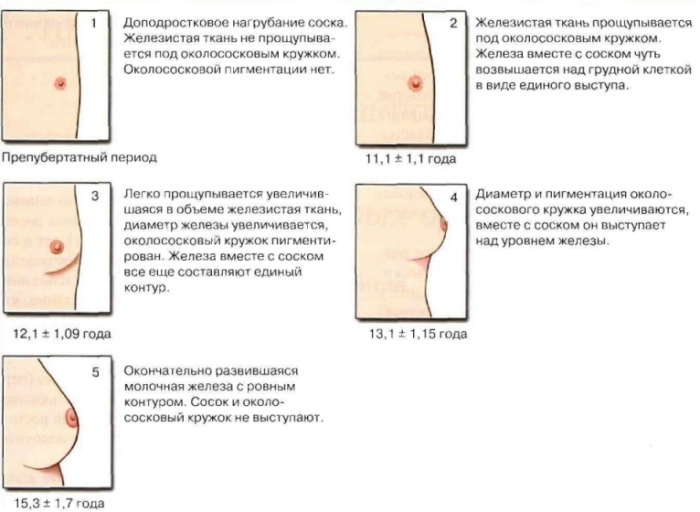Content
- What is allergy and what can it lead to?
- Is it possible to identify allergies without special tests
- Indications for diagnostics and allergy tests
- Allergen detection method
- Skin tests
- Blood analysis
- Provocative tests
- Elimination tests
- How much does allergy tests cost?
- Allergy Test Videos
Allergy analysis in adults and children - a type of diagnostic study that allows to identify with a high degree of certainty the factor that causes an allergic reaction and to determine how great the risk of its development is for the patient. It is important to know in what cases such studies are required, how they are performed and what is necessary to obtain a reliable result.
What is allergy and what can it lead to?
Allergy is the reaction of the immune system to an irritant that does not pose a threat to the body, but is mistakenly identified by it as dangerous.
The development of allergies occurs according to the following scheme:
- At the first (asymptomatic) contact with an allergen, due to an "error" of the immune system, they begin in excessive amounts of antibodies are formed - IgE immunoglobulins, designed to combat imaginary "Enemy".
- With repeated exposure to the allergen, the existing antibodies enter into a biochemical reaction with it, releasing mediator substances from the mast cells. In particular, histamine and prostaglandins, which cause allergy symptoms.
An allergic reaction can manifest itself with varying degrees of intensity, starting mild, barely noticeable symptoms and ending with the most dangerous form - anaflexia, which can pose a direct threat to life.
Depending on the type of allergen, it can manifest itself in different ways, causing:
- skin irritation and rash that appears soon after eating, tingling or numbness in areas of the lips and tongue, sneezing, lacrimation, stomach cramps, swelling of the face, neck, throat - with food allergies;
- rampant sneezing, itching in the nose and eyes, nasal congestion, runny nose that does not disappear with the usual drugs, redness of the eyes and swelling of the eyelids, sore throat, dry paroxysmal cough - with inhalation allergies;
- severe swelling of the bite site, difficulty breathing, pain in the chest area, sudden onset of redness and itching throughout the body - with insect allergies (insect bites);
- itching and rashes on the skin, the appearance of edema on the face and neck, dryness and peeling of the skin - with drug allergies.
Epidermal allergy, a reaction that occurs when an allergen comes in contact with the skin, has similar symptoms.
It is necessary to distinguish between true allergies and pseudo-allergies, a natural and normal reaction of the body that occurs when excessive consumption of any product or an overdose of medication. The main difference: the intensity of the symptoms of pseudo-allergy depends on the amount eaten (drunk, taken), the true allergy manifests itself regardless of the amount of allergen that has entered the body.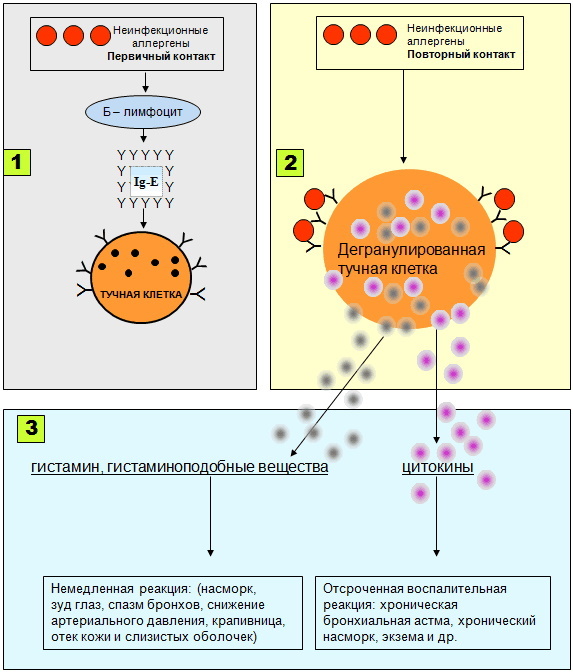
For example, if a person, having sipped a glass of orange juice, becomes covered with a rash, this is an allergy. If the rash appeared after he drank 2 liters of juice at one time, then this is pseudo-allergy.
Allergic reactions differ in the rate of onset of symptoms (from a few seconds to several days), as well as in the mechanism of action and the type of antibodies:
- anaphylactic;
- cytotoxic;
- immunocomplex;
- delayed-type reactions.
Modern allergology assigns the main role in the development of allergies to heredity. There are a number of provoking factors that can trigger the pathological process.
These include:
- inadequate diet;
- regular high loads on the nervous system;
- excessive consumption of drugs;
- environmental problems;
- acute and chronic diseases of the respiratory system;
- abuse of household chemicals.
If you have an allergy, you should consult a doctor, even if its manifestations are minor, since it can give rise to the development of non-allergic diseases.
For example:
- Regular scratching for itchy skin thinns and weakens the skin. She becomes more vulnerable to fungal, viral parasitic infection;
- constant redness and tearing of the eyes, their frequent rubbing leads to hypertrophy of the cornea and, as a result, to the appearance of various vision problems;
- inflammatory phenomena covering the stomach and intestines with food allergies lead to process disturbances absorption of nutrients from food, the development of vitamin deficiency and, over time, can cause gastrointestinal diseases;
- the accumulation of mucus in the respiratory tract with inhalation allergies create fertile ground for the development of bronchial asthma.
Even more serious complications include:
- anaphylactic shock;
- convulsions;
- frequent dizziness;
- development of Quincke's edema.
Today there are no drugs that can permanently get rid of allergies.
However, modern medicine offers the following methods of dealing with it:
- taking antiallergic drugs that block the production of mediator substances and eliminate allergy symptoms;
- allergen-specific immunotherapy, in which the patient is injected with constantly increasing doses of the allergen, as a result of which he temporarily stops responding to them;
- exclusion of any contact with the allergen.
In an emergency, in case of an acute allergic reaction causing respiratory arrest or other conditions, life-threatening, a dose of epinephrine is administered to the patient to relieve symptoms pending medical attention.
However, first, to confirm the fact of allergy, to determine a specific substance (product, medicine), which caused it, and the choice of the optimal method of treatment, it is necessary to carry out a full research.
Is it possible to identify allergies without special tests
It is possible to identify an allergen in an adult on your own if the relationship of cause and effect is obvious.
However, even in this case, it is desirable to perform a full examination for a number of reasons:
- self-diagnosis is not able to identify a specific factor, which becomes the cause of unnecessary restrictions. For example, you can self-diagnose a dairy allergy. But what exactly their component causes the pathological reaction remains a mystery. As a result, a person refuses all products of this type, which, perhaps, is unnecessary;
- errors are not excluded: their probability is especially high in difficult cases when there are 2 allergens acting together;
- the following situation is possible: an allergic reaction caused by a certain factor "A" is so weak that a person does not pay attention to it. But in the presence of a certain factor "B", it manifests itself more clearly. As a result, it is factor "B" that is considered an allergen, and the true "culprit" remains unnoticed;
- you can mistake the symptoms of a disease for an allergy, sometimes requiring emergency treatment. For example, liver disease can present with itchy skin, which is aggravated by eating certain foods. With self-diagnosis, it is highly likely that they will replenish the list of allergens without any reason.
An accurate determination of the allergen will make it possible to choose the method of treatment and the drug that will give the most complete therapeutic effect.
Indications for diagnostics and allergy tests
In order to exclude errors that are possible during self-diagnosis, it is advisable to visit an allergist if you suspect an allergy.

There are also circumstances in which a visit to a specialist is mandatory:
- bright manifestations of allergies associated with the consumption of certain foods, which are seasonal in nature, significantly reducing the quality of life;
- lack of a visible effect in the treatment of colds, skin diseases, gastrointestinal pathologies with conventional drugs;
- genetic predisposition (the presence of allergies in one or both parents);
- work in "harmful" production.
In the last 2 cases, an allergist consultation is needed, even if there are no obvious manifestations of allergy at the moment.
Allergen detection method
Various examinations help to identify an allergen in an adult.
However, first, an oral conversation with the patient is carried out, during which the doctor may ask questions regarding:
- the nature of the symptoms of the alleged allergy;
- when and after what actions they appear;
- what their intensity depends on;
- whether there are similar symptoms in relatives in the ascendant;
- whether the patient is taking any medications.
Next, a visual inspection is performed.
Depending on the symptoms, the doctor may be interested in:
- type of skin;
- eye condition;
- the presence or absence of puffiness in the lower part of the face or neck.
The purpose of the survey and examination is to narrow down the search for a specific allergen.
After that, the diagnostic scheme is traditionally used, which includes 3 stages:
| Stage | Description |
| 1 | Determination of the level of total IgE. At this stage, it is ascertained whether an allergy is really present or whether the symptoms indicate a disease. For this purpose, a number of tests are performed: for example, food, inhalation, general (the most likely options are selected based on the results of an oral conversation). Depending on the type of allergen and the nature of the allergic reaction, a different biomaterial can be used to perform the test. This could be:
If a negative test result is highly likely to indicate the absence of allergies, then with a positive result everything is ambiguous, since there are other causes of increased IgE, in particular, parasitic infections and immunopathological diseases. |
| 2 | Determination of specific IgE - antibodies inherent in a certain group of allergens is performed if at least one of the tests performed earlier gave a positive result. For this purpose, testing is carried out with mixtures of possible allergens. For example, if the 1st test indicated the possibility of an inhalation allergy, the 2nd stage could be tested for pollen, household dust, and mold. |
| 3 | Detection of allergen-specific IgE - testing to identify a specific allergen. For example, if according to the result of the 2nd stage it was found that the patient is allergic to pollen, then at the 3rd stage it is determined which pollen of which plants causes the allergic reaction. |
Other techniques can be used when performing tests.
Skin tests
They are referred to “in vivo” procedures: they involve the patient's direct participation in the study. The method consists in applying the suspected allergen to the skin (injected under the skin) and assessing the response to the irritant.
When performing the procedure:
- An area of skin on the elbow or back is carefully treated with an antiseptic.
- The site is divided into separate zones, each assigned a serial number.
- A specific allergen is applied to each of the zones.
- A control area is allocated in advance, which is treated with a neutral solution.
Sometimes a second control zone is also isolated, on which histamine is applied, which in 100% of cases causes an allergic reaction
You can identify an allergen in an adult by using various methods of applying the allergen.
As a result, the following samples are distinguished:
| Sample type | Description |
| Application | Used when contact dermatitis is suspected. During the test, a piece of tissue is soaked in a solution containing a specific type of allergen and applied to the skin.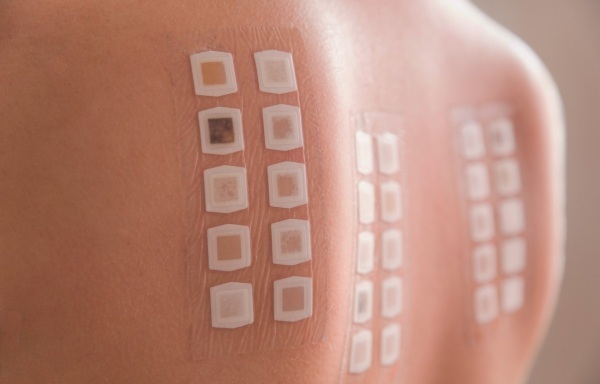 The result is evaluated three times:
The main criteria are the intensity of the initial reaction and the time it takes for the skin to regain its normal appearance. |
| Scarifice | They are used for a quick reaction to an allergen: solutions containing different allergens are applied to separate areas. Further, with the help of a scarifier, a shallow scratch is made on each of the sections (the outer layer is slightly damaged, but the blood vessels are not touched at the same time). Evaluation of the result by the appearance of the skin - after 15 minutes. |
| Intradermal | Tests of this type give a good result for allergies to fungi or bacteria, with some types of non-infectious allergies. In this case, the allergen is injected subcutaneously at a shallow depth. The result is assessed after 20 minutes. The presence or absence of allergies is judged by the appearance of the skin, and by the size of the zone - how strongly the body is susceptible to an allergic reaction. For example, when:
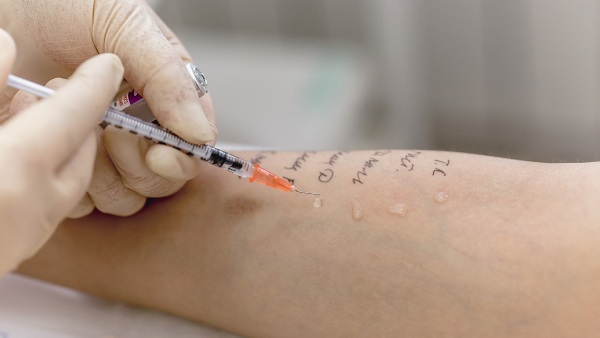 |
The obtained results are considered reliable only under the condition of a "correct" reaction to neutral liquid and histamine from the control sites.
Inaccurate results can be obtained from:
- errors during the procedure;
- improper storage of reagents;
- incorrect preparation of the patient.
The advantages of the method include:
- visibility;
- accuracy;
- the ability to quickly obtain results.
However, there are also disadvantages associated with the fact that the patient has to directly participate in testing.
This is a complex preparation for the procedure, its invasiveness and a large list of contraindications, which includes:
- allergy in the acute stage;
- diseases that have developed against its background;
- acute viral infections;
- high probability of a pronounced reaction to an allergen;
- conducting a test while taking antihistamines and other drugs, which can distort its result;
- pregnancy;
- childhood.
Preparation for performing a test is reduced to bringing the IgE indicator as close as possible to normal values, since the reliability of the result depends on this.
The patient is advised to:
- 2 weeks before the examination - stop taking glucocorticosteroids (steroid hormones responsible for the level of glucose in the blood), as well as the use of any hormonal ointments and creams on the site selected for tests;
- in 1 week - stop taking antihistamines, limit contact with the alleged allergen as much as possible, and also with any other substances, preparations, foodstuffs that are capable of giving an allergic reaction;
- in the morning, before performing the procedure, be sure to have breakfast.
Blood analysis
Identifying an allergen in an adult with this method is beneficial from the previous one in that it is supposed to be performed diagnostic procedures "in vitro" - without the direct participation of the patient, who is only required to pass blood from a vein. The method is considered the safest, incapable of giving side effects.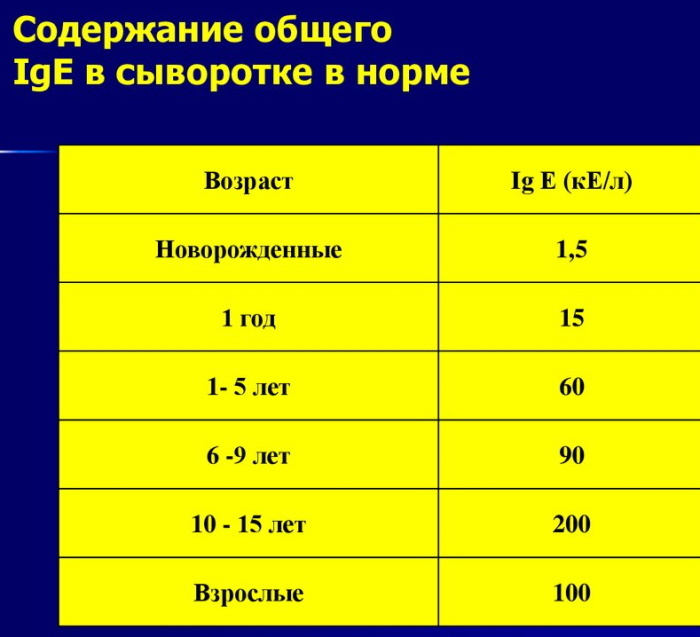
Most often, when carrying out diagnostics, an enzyme-linked immunosorbent assay is used, which makes it possible to assess the presence or absence of antibodies based on the results of a specific antigen-antibody reaction. Further, by the amount of IgE in comparison with normal values, the result is evaluated.
Reference (normal) parameters are:
| Age | Reference values (IU / ml) |
| Less than 1 year | 0-15 |
| 1-6 years old | 0-60 |
| 6-10 years old | 0-90 |
| 10-16 years old | 20-200 |
| Over 16 years old | 20-100 |
When the actual IgE exceeds this indicator and depending on the specific values, a conclusion is made about a weakly positive, positive, sharply positive reaction.
In the described variant of research, the patient has to donate blood several times, which creates for him certain inconveniences, and sometimes (with anemia, small body volumes and, accordingly, blood) causes direct harm to health. For this reason, in the presence of such problems, screening tests are used in the diagnosis of mixed allergies, and in especially difficult cases.
The essence of the method is to perform a complex analysis, for which the so-called allergic panels are used. Each panel is a form with samples of possible allergens printed on it. Blood is taken once, after which each sample is processed with a small amount. The results are assessed by a change in its appearance (color), indicating the presence of antibodies.
In a simple test, the panel contains the 20 most common allergens. In extended testing, specialized allergy panels are used, on which allergens of a certain type are present (food, household, epidermal, pollen). Each of the panels can have from several dozen to several hundred positions.
The main advantage of the method is its implementation without the presence of the patient and the associated safety, minimum restrictions during the preparatory period. Among the disadvantages are the possibility of errors, a long waiting time for the result.
Blood for analysis is given during the period of remission, in the morning (from 8 to 11 o'clock), on an empty stomach.
During the preparatory period, it is recommended:
- the day before the procedure - refuse alcoholic beverages;
- in the evening before the procedure - avoid excessive consumption of heavy food;
- 2 hours before the procedure - stop smoking, avoid high physical and emotional stress.
Contraindications to blood donation include only obvious health problems:
- high fever;
- acute respiratory infections;
- gastrointestinal diseases in the acute stage.
Refusal to take antihistamines is not required.
Provocative tests
If, after applying the diagnostic methods described above, a more precise diagnosis is required (with controversial IgE indicators), provocative tests are prescribed. In them, a small amount of the alleged allergen is injected directly into the organ, which shows the most striking allergic reaction.
There are tests:
- conjunctival, used to detect allergic conjunctivitis: a solution with an allergen is instilled into the eye. A positive reaction is indicated by the appearance of edema, redness, itching;
- nasal, aimed at identifying allergic rhinitis. The solution is injected into one of the nasal passages, when itching, sneezing, mucosal edema, allergy is diagnosed;

- inhalation: a patient with suspected inhalation allergy is asked to inhale the allergen. The result is assessed according to the spirogram data;
- cold (heat) is aimed at confirming allergic urticaria. A container with ice or warm water is placed on the skin, then the condition of the skin is assessed;
- leukocytopenic and thrombocytopenic: used in the diagnosis of drug allergies. After the injection of the allergen, the number of leukocytes and platelets is assessed based on the results of a blood test.
Since performing provocative tests comes with a certain risk and can lead to drastic deterioration of the patient's condition, they are performed only in a hospital under strict supervision doctor.
Elimination tests
In adults and children, when allergies are detected in controversial cases and to clarify the diagnosis, elimination tests are used. With them, the patient's contact with the alleged allergen is completely excluded. A striking example is an elimination diet that does not contain a problem product. Conclusions are made on the basis of the patient's health indicators, which are assessed after a certain period of time. If the allergy symptoms disappeared during this time, the excluded substance was indeed an allergen.
The method is absolutely safe, but its use is possible only in a limited number of cases, if allergens that can be completely eliminated, and not too much is required to obtain a visible effect time. If these conditions are not met, the test will be useless.
For example, in case of an allergy to animal hair, even if the pet is eliminated, the allergic reaction will be maintained in for six months due to the presence of microparticles of his wool in the air, which cannot be removed by the most careful cleaning.
How much does allergy tests cost?
The price you have to pay for the diagnosis depends on the type of research and the level of the clinic. For example, allergy skin tests done at the Central Clinical Hospital (Moscow) will cost no less than 2,000 rubles. (analysis for allergens of a certain type, for example, inhalation) and 500 rubles. (analysis for a specific type of allergen, for example, egg yolk).
The most expensive is the blood test. In the capital clinic "Gemotest" it will cost from 1500 rubles. (analysis for a small number of allergens) and up to 26,000 rubles. (extended test for 112 allergens and 51 sources of allergenic substances).
If you narrow your search, having previously received the advice of an allergist, if you remember that diagnostics will reveal the main "enemy", find a remedy against it and forever get rid of the fear of allergies to an adult or a child, then, perhaps, the amount spent will be small.
Allergy Test Videos
How to find out what you are allergic to:


